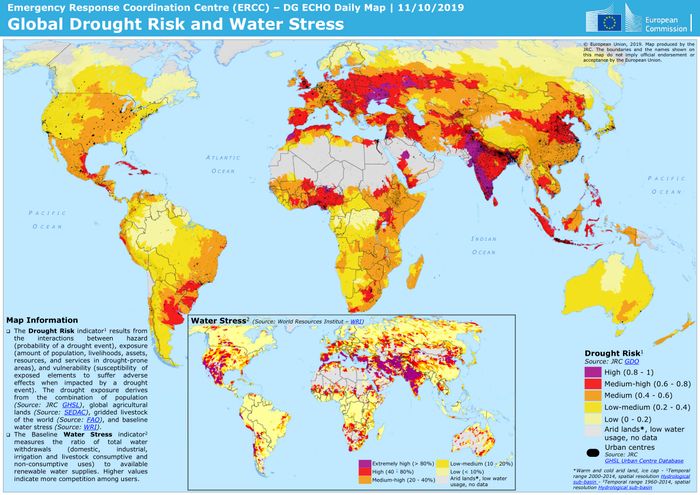
BONN – Drought may be an ancient scourge, but it is getting worse. No region or country today is immune to its effects. Southern Europe is in the grip of a severe drought – the worst in 70 years for Italy. In the western United States, the past two decades have been the driest in 1,200 years. Chile is in its 13th consecutive year of drought, and Monterrey, Mexico’s third-largest city, is now being forced to ration water.
In the Horn of Africa, Ethiopia, Kenya, and Somalia are recording their fourth consecutive year without rains, and the situation has grown increasingly dire for people, livestock, and the ecosystems that support them. Owing to a lack of adequate nutrition, children are dying from diseases they would ordinarily survive. Even camels – which typically survive longer than people or other animal species – are dropping dead in large numbers across this region.
This suffering evokes traumatic memories of my own first encounter with drought in Mauritania. I was barely 12 years old when every household in our community lost everything – food, livestock, and their livelihoods. Unable to provide for their families, many adults took their own lives. The experience has stayed with me, motivating my efforts to ensure that no more children have to live through what I did. Sadly, many still are being traumatized by drought, and many more soon will be: Scientists project that climate change will increase the frequency, duration, and geographic spread of droughts, with three out of four people affected by 2050.
Areas across all regions are becoming drier, and while there is not yet a consensus on where exactly the most acute drought conditions will emerge, scientists agree that land degradation exacerbates the problem. Worse, the Intergovernmental Panel on Climate Change’s sixth assessment report warns that we are not making sufficient progress to reduce greenhouses-gas emissions and avert even more severe conditions in the decades ahead.
Together, recent traumatic experiences and the latest scientific projections should convey a sense of urgency, compelling everyone to build resilience against future drought risks. Drought is a natural phenomenon; but it need not become a natural disaster. Land degradation can be mediated at least partly with better land- and water-use decisions and land-restoration initiatives.
In a recent report, the Food and Agriculture Organization of the United Nations and the UN Convention to Combat Desertification (UNCCD) identify successful examples of systems that have reduced drought risk among vulnerable populations. In Brazil, Ethiopia, India, and Tunisia, a combination of water harvesting and sustainable land-management practices are being used to reduce the impact of droughts. While it may take time, all countries can adopt similar strategies to help move their people from water scarcity toward water security.
A major shortcoming of the current approach, however, is that it is based on national systems, even though droughts do not observe political boundaries. Proactive planning across sectors within countries is essential; but without international collaboration, the effects of drought eventually will reach other countries. Common knock-on effects include conflicts over diminished water resources, soaring food prices or shortages, wildfires, mass wildlife and livestock loss, sand and dust storms, human displacement and forced migration, and civil unrest.
Collaborative arrangements to anticipate and respond to droughts quickly can avert or reduce the scale of these outcomes. Australia and the US, for example, have long had policies and planning protocols in place to ensure that affected communities can endure droughts with dignity.
Building such resilience globally will take time and political will. Fortunately, even in the world’s most vulnerable regions, policymakers already have foundations that they can build on. For example, Africa’s Sahel has a regional drought-risk system, set up 50 years ago to bring together a broad range of stakeholders, from producer associations to political decision-makers, and benefits from the pooling of scientific and technological capabilities at the regional level.
India has adopted an even more comprehensive approach that includes drought management as part of its national disaster-management plan. An intricate strategy is in place to include all the relevant government ministries and closely coordinate national, state, and local responses. After a process that started 15 years ago, India now has an integrated water-management system that also serves as a drought warning system.
In June, the US announced that drought will henceforth be considered a strategic domestic and foreign-policy priority. As home to one of the most sophisticated and advanced drought-monitoring and response mechanisms in the world, the US could help to fast-track the development of better risk-management systems globally.
Around the world, there is a strong appetite among governments to act quickly before the effects of increasingly frequent and severe droughts become unmanageable. And following the creation of an intergovernmental working group on drought at the UNCCD’s summit in May, we now have a platform for mobilizing collective action according to what the science says is necessary.
We can rein in drought impacts together. But all leaders, down to the community level, will need to commit to doing what it takes to build effective resilience – starting immediately.
Ibrahim Thiaw is Executive Secretary of the UN Convention to Combat Desertification.
Copyright: Project Syndicate, 2022.
www.project-syndicate.org
















